Eight colourful dishes to try during Holi
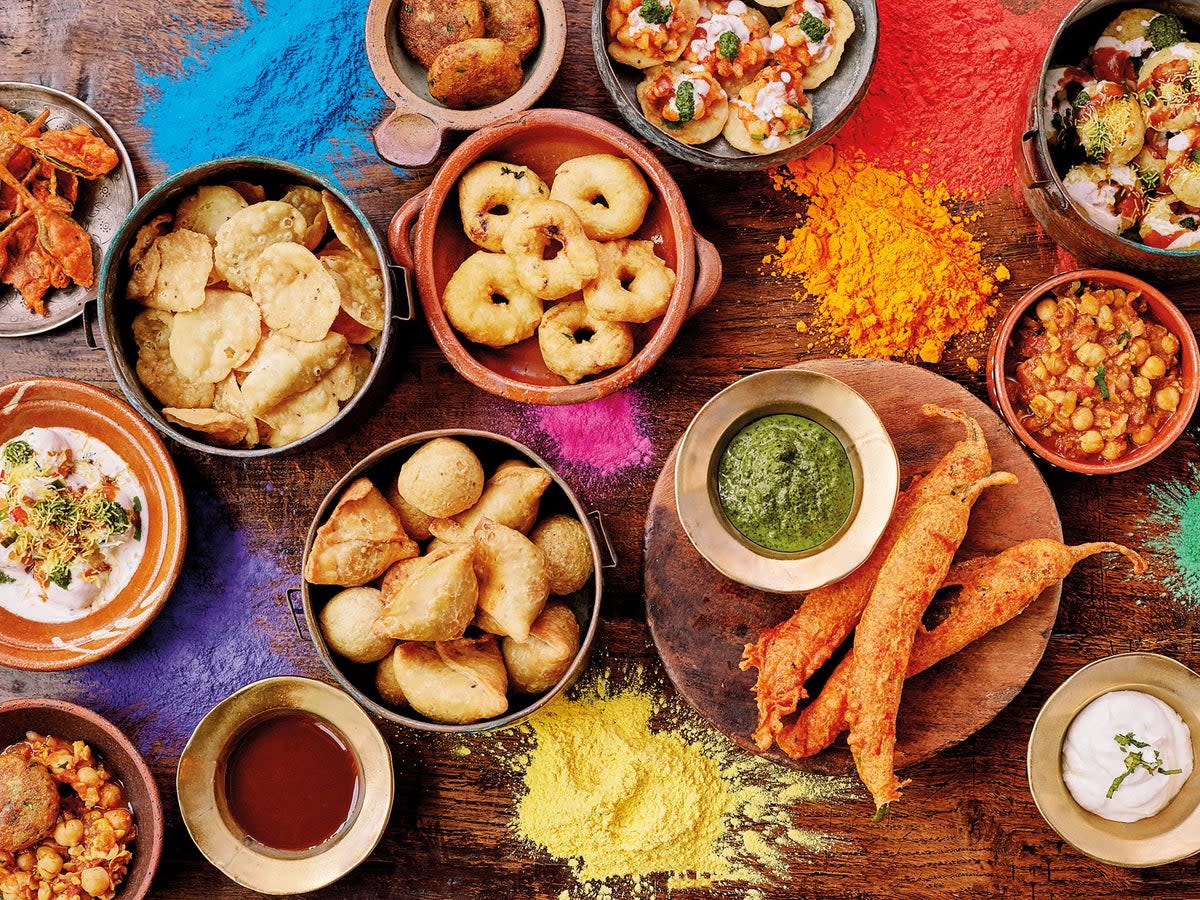
It’s that time of year again when people perform nighttime rituals in front of bonfires to pray away their internal evil, and wake up the next morning, gather in the street and hurl coloured powder at each other – made to stick with water guns and balloons – in a riot of of boisterous fun and pure joy. And then, a bath and a feast.
I’m talking, of course, about the ancient Hindu festival Holi. Otherwise known as the festival of colour, Holi marks the end of winter and beginning of spring – my absolute favourite time of year – and in 2024 it falls on 25 March.
It’s celebrated all over the world in different ways. Whether you’ve got two days of festivities planned or you’ll be seeing in the new season in a quieter celebration, the food definitely should not be missed.
From mathris and dumplings in the morning, to fried pancakes (known as malpua) and kulfi to go with a glass of chilled thandai, these recipes from Vivek Singh, the Indian British chef behind The Cinnamon Collection restaurants, have got you covered... while you go cover everyone else in colour.
Subz mutter pulao (mixed vegetable pilau)
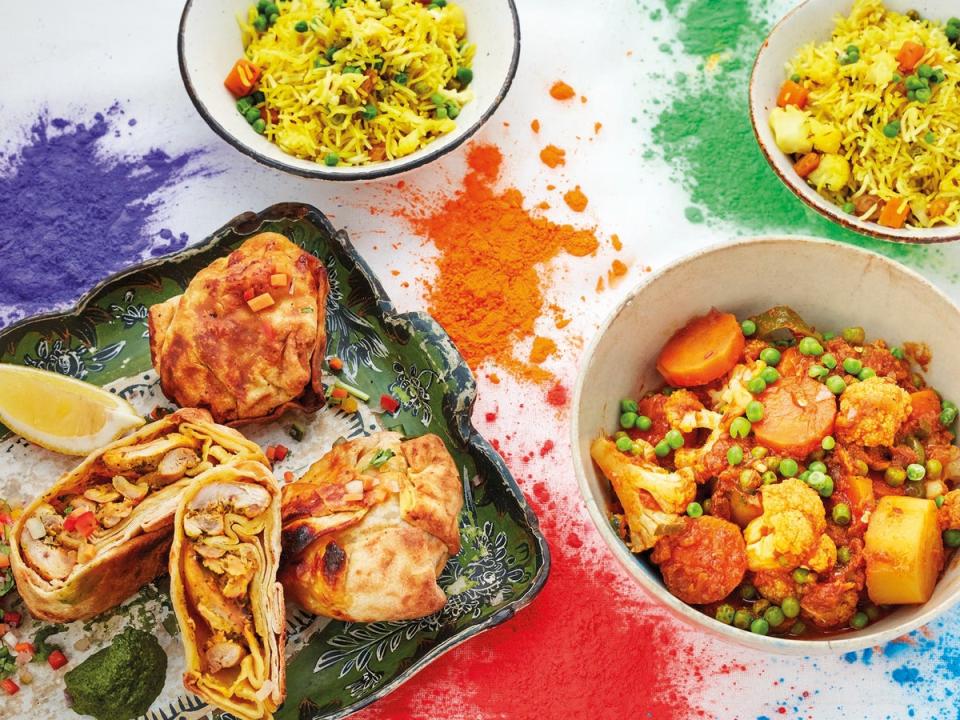
In northern India, this vegetable pilau is a firm fixture on most menus at Holi. These are the vegetables that are in season at that time in India, but feel free to replace with whatever seasonal root vegetables you may be able to find. It’s just as flexible with a choice of dried fruits and nuts. My mother nearly always makes this dish when she’s entertaining, and she always serves it at Holi.
Serves: 6-8
Ingredients:
400g basmati rice
75g ghee
1 cinnamon stick
3 bay leaves
4 black cardamom pods
½ tsp cloves
1 tsp cumin seeds
2 red onions, finely sliced
100g cauliflower, cut into 1cm florets
1 carrot, diced into 1cm cubes
1 tsp ground turmeric
4 tsp salt
1 tsp sugar
4 green chillies, cut lengthways
100g frozen petits pois or garden peas
2 tbsp ready-to-eat raisins
2 tbsp freshly chopped coriander
2 tbsp freshly chopped mint leaves
50g cashew nuts, deep fried and coarsely chopped
Method:
Wash the rice under cold running water, then soak in a bowl of water for 10 minutes (soaking the rice reduces its cooking time and helps to prevent the grains breaking up while cooking).
Heat the ghee in a heavy-based pan. Add the cinnamon stick, bay leaves, cardamom and cloves and allow them to crackle for a minute or so, then add the cumin seeds. As they start to splutter, immediately add the sliced onions and sauté for 3-5 minutes until they begin to change colour. Add the cauliflower and carrot and stir to mix well, then reduce the heat and sweat for 2-3 minutes. Add the turmeric, salt, sugar and green chillies, and cook for another minute until the turmeric is thoroughly mixed in.
Add the drained rice and carefully stir to mix all the ingredients together. Be careful not to overwork the rice as the grains may break. After a minute or so, mix in the peas and raisins.
(At this stage, you could remove the rice from the heat and let it cool, then store in a refrigerator for a couple of days if you want to get ahead but not finish the pilau just yet.)
To finish the pilau, in a separate pan bring 1 litre of water to the boil, keeping the pan covered with a lid. When the water is boiling, add it to the sautéed rice and vegetable mixture and bring back to the boil. Gently stir over a medium-high heat, remembering that too much handling may break the rice grains.
When the water is nearly absorbed and you can see small holes on the surface of the rice in the casserole, sprinkle over the coriander and mint, cover the pan with a tight-fitting lid and reduce the heat to low for 8-10 minutes (alternatively, place in the oven at 120C/100C fan/gas mark ½ for 10 minutes for the rice to finish cooking). Sprinkle with the fried cashew nuts before serving.
Dahi vada
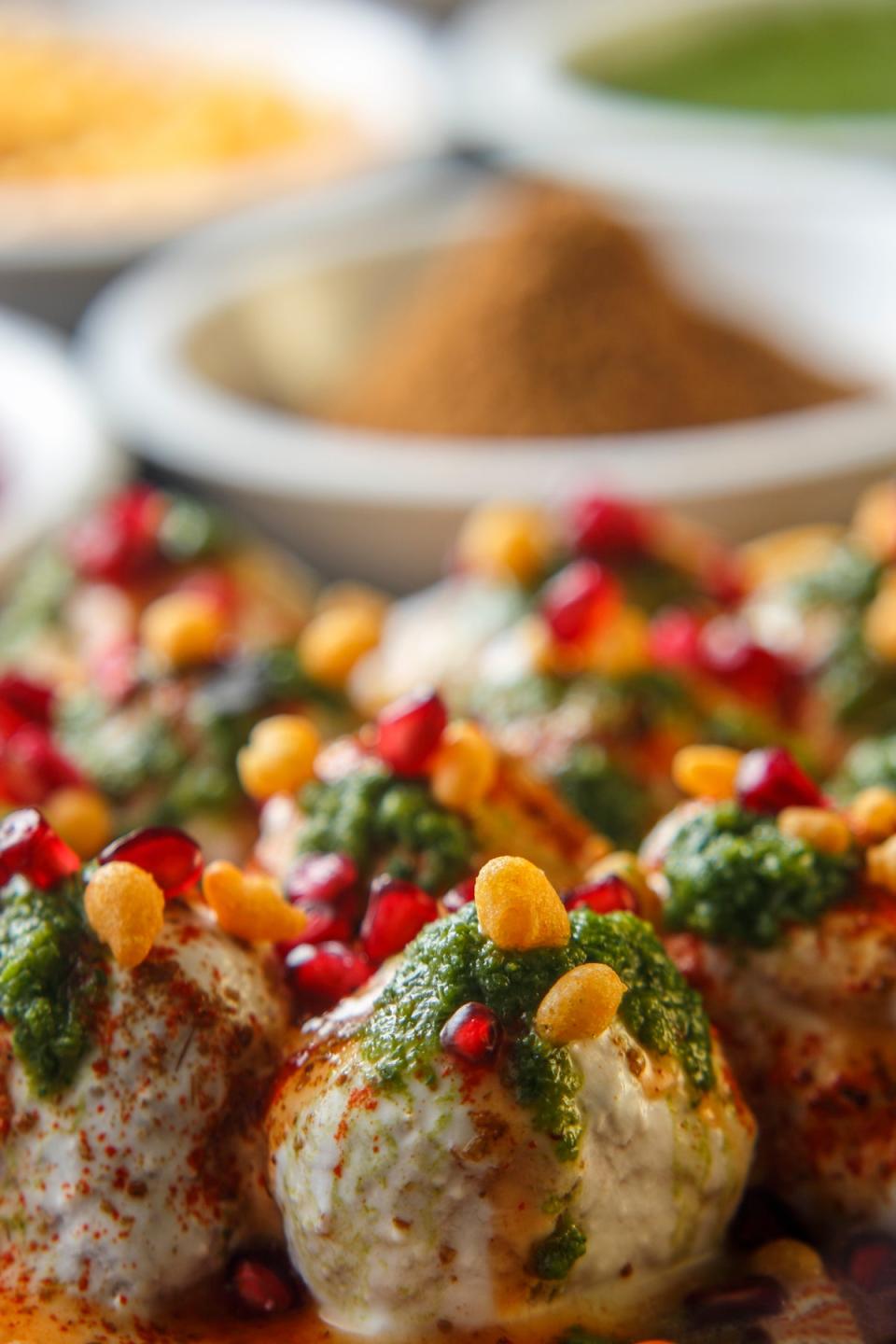
These chilled lentil dumplings are perfect as an anytime snack and are often served on hot summer afternoons or balmy evenings in India. Feel free to sprinkle some Bombay mix or crushed nuts on top for that extra texture.
Ingredients:
For the lentil dumplings:
200g white urad dal
1½ tsp salt
1 tsp black peppercorns, coarsely crushed
1 tbsp golden raisins
2 tbsp semolina
Vegetable oil, for frying
For the yoghurt mixture:
600ml plain yoghurt
2.5cm piece of fresh ginger, finely chopped
2 green chillies, finely chopped
2 tbsp freshly chopped coriander
½ tsp asafoetida
2 tsp cumin seeds, roasted and coarsely crushed
1 tsp red chilli powder
1 tsp salt
1 tsp sugar
To garnish:
Tamarind chutney
Green coriander chutney
2 tbsp pomegranate seeds
Micro cress
Method:
Rinse the lentils in cold running water and soak in water overnight.
Drain the lentils and blend, adding just enough water to blend to a mixture slightly thicker than double cream.
Add the salt, black peppercorns, raisins and semolina. Whip together with a spoon until the batter is light and fluffy.
Heat the oil in a deep pan. Divide the batter into 12 round balls of equal size and deep fry them until golden brown in colour.
Remove from the oil with a slotted spoon and soak the fried dumplings in a bowl of lukewarm water for 20 minutes until soft. Squeeze out the excess water and place them in a deep dish.
Beat the yoghurt with a whisk until smooth (add some water if required).
Add the remaining ingredients and pour over the dumplings, covering them entirely. Place in the fridge for 30 minutes to chill.
Serve the lentil dumplings garnished with tamarind chutney, green coriander chutney and pomegranate seeds. Garnish with micro cress, if using, and serve chilled.
Khela kalia (holiday meat curry)
This is a kind of celebration meat dish that can be prepared on any holiday, be it on account of Holi, Dussehra, any bank holiday or even a Sunday! In my ancestral village in Ballia, it is called khela kalia and in Bengal, there is a similar recipe that goes by the name Sunday special meat curry (robibarer mangsho).
Serves: 6
Ingredients:
1kg goat meat, diced into 2.5cm cubes (usually on the bone)
6 tbsp plain yoghurt
2 tbsp mustard oil (optional)
2 bay leaves
2 black cardamom pods (optional)
1½ tsp cumin seeds
4-5 hot green chillies
2 tbsp vegetable oil or Ghee
4 potatoes, peeled and halved
4 red onions, finely chopped
2 tbsp ginger-garlic paste (see page 260)
1 tbsp ground coriander
1 tsp ground turmeric
2 tsp red chilli powder
2 tsp salt
2 tbsp freshly chopped coriander leaves
For the rustic garam masala:
6 green cardamom pods
5cm cinnamon stick
8 cloves
1 tsp black peppercorns
Method:
Start by marinating the meat with the yoghurt and mustard oil, if using, and set aside for about 30 minutes.
Make the rustic garam masala by grinding the spices together.
Blend the cumin seeds and green chillies together in a mortar and pestle to make a coarse paste.
Heat the oil in a large heavy-based pan, add the potatoes and gently fry for 3-5 minutes until coloured on the outside. Remove from the pan and set aside.
Add the bay leaves, black cardamom to the same oil and let sizzle for 30 seconds, then add chopped onions and sauté for 8-10 minutes until the onions start changing colour, then add the ginger-garlic paste and the cumin-chilli paste. Fry them with the onions for 3-5 minutes and when you see the oil separating, add the ground spices, red chilli powder and 2 tablespoons of the rustic garam masala. Continue to cook over a low heat, stirring continuously to make sure the spices do not burn.
When the oil starts to separate, add the marinated meat and salt. Slightly increase the heat and continue to bhunno (ie to sauté well, to heat the spices sufficiently so the oils are released from them) the meat for about 15-20 minutes until the meat appears browned at the edges and the juices have evaporated.
At this point, either transfer the meat to a pressure cooker or continue cooking in the same pan. Either way, add the potatoes, the remaining tablespoon of garam masala and the ghee, then stir to mix. Add 475ml of water if cooking in a pressure cooker, or 1 litre of water if cooking in the pan. Reduce the heat and cook until the meat is tender and the potatoes cooked through; this should take 15 minutes in a pressure cooker, or 45 minutes in a pan. Reduce the heat and simmer until the gravy is thick and rich.
Check the seasoning and serve immediately with either pulao or poories, and garnish with the chopped coriander leaves.
Thandhai (spiced milk cooler)
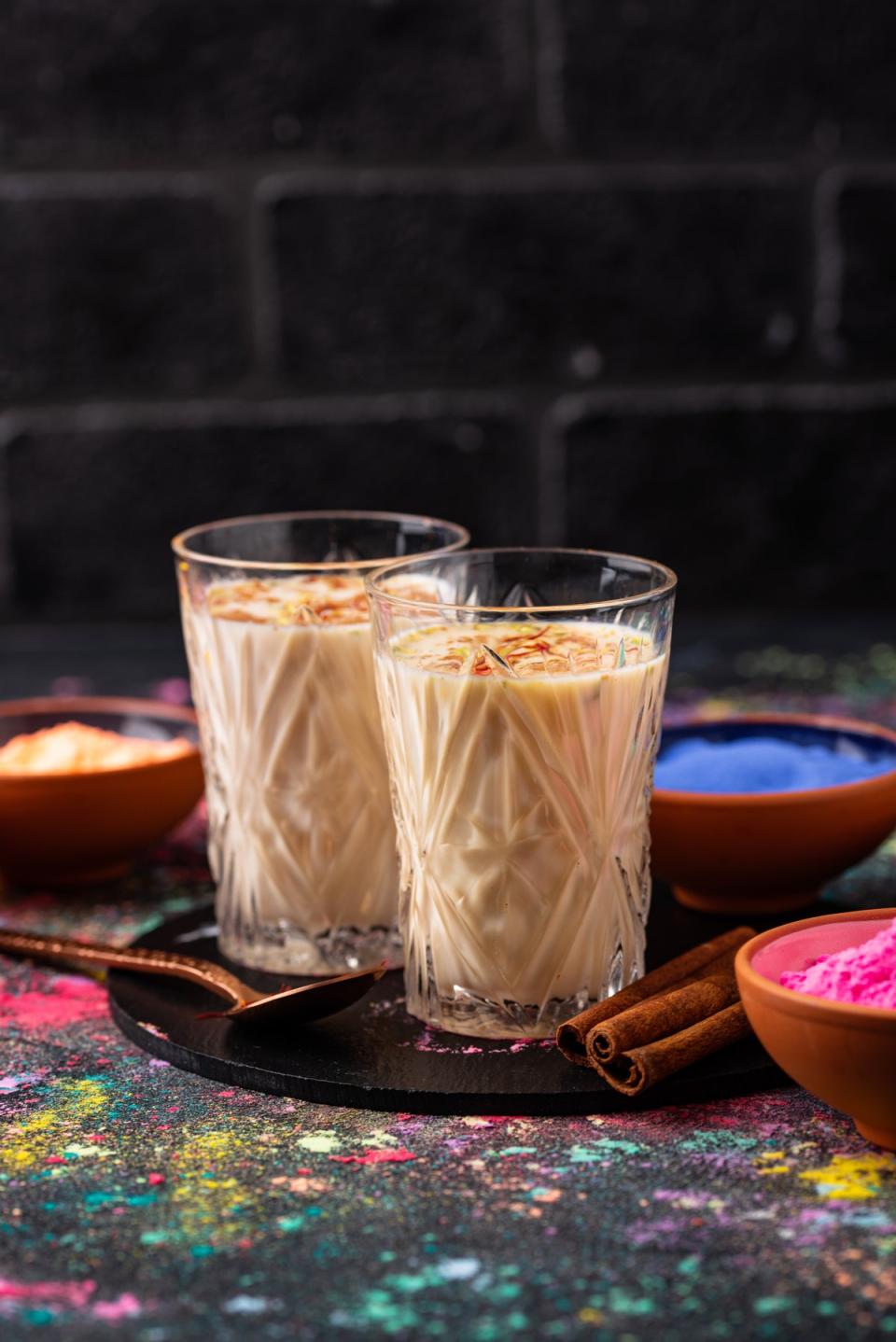
This is the base for the quintessential Holi drink bhaang. Originally supposed to be spiked with a paste of cannabis leaves, it is believed to be Shiva’s preferred drink. Without the cannabis, thandhai is still a great refreshing drink to be enjoyed on any hot day.
Serves:8-10
Ingredients:
120g sugar
3 tbsp ground almonds
1 tbsp melon seeds
½ tbsp fennel seeds
½ tbsp white poppy seeds
½ tsp black peppercorns
25 g dried rose petals
250ml milk
½ tsp ground cardamom
½ tsp rose water
Method:
Dissolve the sugar in 500ml of water and set aside.
Mix all the other ingredients, except the milk, cardamom and rose water, together and soak in 500ml of water. Keep aside for 2 hours.
Grind all soaked ingredients to a very fine paste using a mortar and pestle or electric blender.
Add another 500ml of water to the paste and pass it through a fine sieve or muslin to extract all the liquid. Add the sugar solution, milk, cardamom and rose water to the extracted liquid. Keep refrigerated and serve over cubes of ice.
Kathal ki subzi (jackfruit curry)
One of the most underrated of all Indian fruits, as well as being the largest tree-borne fruit on the planet, jackfruit isn’t the most desirable of fruits when ripe. But in its raw (ie, unripe) form, it is commonly used across India and is highly prized. This dish is a speciality in northern India during Holi. Raw jackfruit curry has a texture like meat in this curry.
Serves: 4
Ingredients:
500g raw jackfruit (available in Indian/Asian supermarkets; alternatively use two 500-600g cans of tinned jackfruit, drained)
2 tbsp mustard oil
½ tsp cumin seeds
½ tsp panch phoron (Indian five spice blend, containing fenugreek seeds, cumin seeds, nigella seeds, fennel seeds and black mustard seeds)
2 bay leaves
2 dried red chillies
1 green chilli, chopped
3 onions, finely chopped
2 tomatoes, finely chopped
½ tsp ground turmeric
1 tsp red chilli powder
½ tsp ground cumin
1 tsp ground coriander
1 tsp salt
1 large potato, boiled, peeled and diced into 2.5cm cubes
½ tsp garam masala
Method:
Peel the jackfruit, remove the seeds and dice into 2.5cm cubes.
Place them in a pan with enough water to cover, bring to the boil and cook for 30-40 minutes or until tender. Alternatively, boil them for 10 minutes in a pressure cooker (2 whistles). Drain and set aside.
Heat the mustard oil in a frying pan to smoking point.
Add the cumin seeds, panch phoron, bay leaves, dried red chillies and green chilli in that order. Cover and leave for 3-4 minutes.
As soon as the red chillies turn dark red, add the chopped onions. Cook over a low heat for 7-8 minutes until the onions are translucent.
Add the chopped tomatoes to the pan. Follow with the turmeric, red chilli powder, cumin, coriander and salt. Stir well.
Add the jackfruit cubes and boiled potato cubes. Cook over a low heat, covered, for 5-7 minutes, then add the garam masala, cook for another minute and then remove from the heat.
Serve with boiled rice
Khad murgh (chicken tikka wrapped in handkerchief bread)
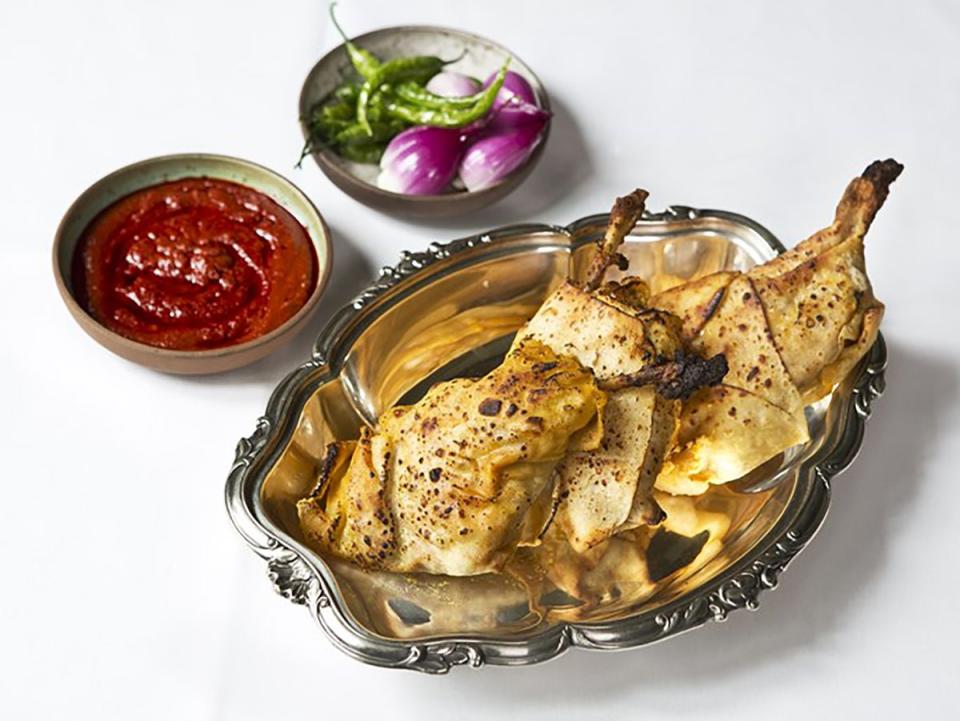
This dish is inspired by how the nomadic tribes would cook chicken in the deserts of Rajasthan – tender marinated chicken wrapped in thin bread, baked for a few hours in a pit dug in the ground and covered with wood and cowpat and then devoured at the end of the day’s expedition. This would be an ideal barbecue dish as the smokiness from the charcoal brings out the flavour of the marinade.
Roomali refers to the bread’s resemblance to a handkerchief, so thin and so large, and is traditionally cooked on an inverted wok. The technique of making this is similar to that of making a pizza; just toss it in the air and watch it grow!
Serves: 4 as a starter
Ingredients:
500g boneless chicken legs, diced into 2.5cm cubes
8 bamboo skewers, soaked in water
For the first marinade:
1 tbsp ginger-garlic paste
½ tsp red chilli powder
1 tsp ground turmeric
1 tsp salt
Juice of 1 lemon
2.5cm piece of green papaya, finely grated (or use 2 tbsp freshly grated pineapple or juice)
For the second marinade:
100ml Greek yoghurt
2 tbsp wholegrain mustard
1 tbsp honey
1 tsp garam masala
2 green chillies, finely chopped
1 tbsp freshly chopped coriander
2 tbsp mustard oil (alternatively use vegetable oil mixed with 1 tsp English mustard)
For the roomali bread:
150g chapati flour (fine ground wholemeal flour)
100g plain flour, plus extra for dusting
½ tsp salt
Method:
Mix together all the ingredients for the first marinade and rub it onto the chicken legs, massaging it well into the meat. Set aside.
Now mix together all the ingredients for the second marinade and add it to the chicken. Marinate for an hour or so in the fridge (you could marinate it overnight too).
Thread the chicken pieces onto skewers and cook on a hot barbecue for 10-15 minutes, turning regularly. Alternatively, preheat the oven to 180C/160C fan/gas mark 4, place the chicken skewers on a baking tray and cook in the oven for 18-20 minutes, turning them regularly. If the chicken cooks but does not take colour, place under a very hot grill for a couple of minutes.
Meanwhile, make the bread. Mix together the 2 flours, salt and 125ml of water and knead to a soft smooth dough (if you wish, you could use 120ml of spinach purée instead of the water to give a bright green bread).
Let the dough rest for minutes, then divide it into 6 equal balls, cover them with clingflm and let them rest for 5 minutes.
Dust your work surface with flour. Roll the dough in thin pancakes about 15cm in diameter, then enlarge the pancakes by tossing like a pizza base. This requires some practice – you usually get plenty of fails, but on the whole, it’s very entertaining! This recipe makes enough dough for 6 pancakes – allowing you a couple of practice runs if necessary!
Once the dough is as thin as you can possibly manage, turn it out onto an inverted wok if you have one or just lay it on a flat griddle over a high heat. and the bread cooks in a matter of seconds!
Preheat the oven to 180C/160C fan/gas mark 4. Wrap a portion of cooked chicken in the thin bread to make a parcel, then wrap the entire thing in foil and bake for about 20 minutes until the bread is crisp.
This is great served with pickled onions and a kachumbar salad (roughly chop onion, carrot and cucumber and mix together).
Kosha mangsho
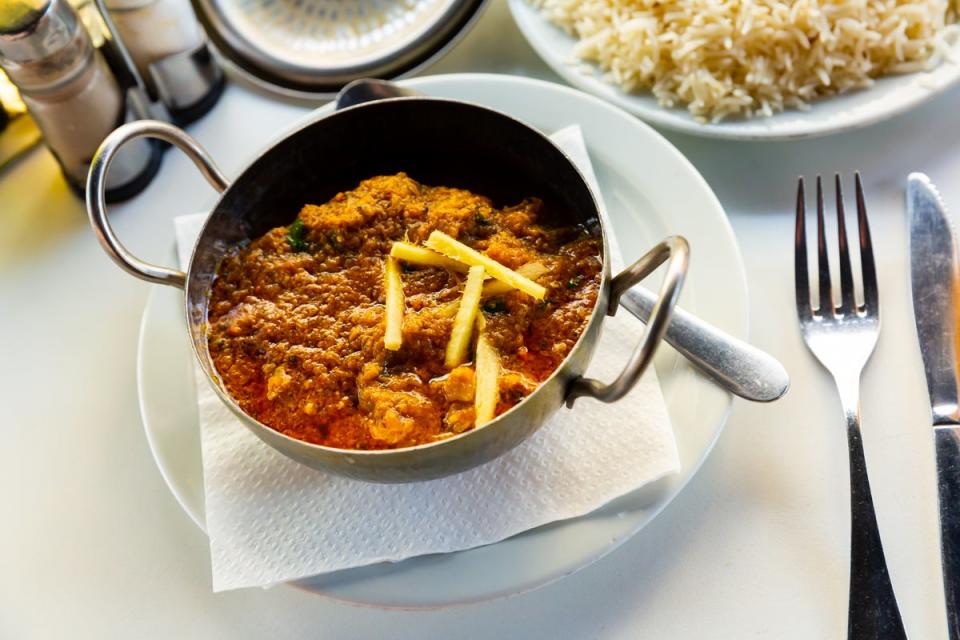
This is a lamb curry from west Bengal, also popular in the state of Bihar and neighbouring areas. The term kosha literally translated means “tightened”, which refers to the drying up of spices to give a rich, finished product. It is often served with a soft khichri (the original kedgeree) on a cold day, and the combination is both comforting and invigorating.
Serves: 4 if the only main meat dish, or 6 as part of a selection of curries
Ingredients:
1kg leg of lamb, diced into 2.5cm cubes
2 tsp salt
3 tbsp ginger-garlic paste
1 heaped tbsp red chilli powder
1½ tsp ground cumin
1½ tsp ground coriander
50ml mustard oil
50g ghee or vegetable oil
3 bay leaves
5 black peppercorns
3 black cardamom pods
4 dried red chillies, each broken into 2-3 pieces
3 blades of mace
6 large red onions, finely chopped
5 large tomatoes, puréed
250ml of water or lamb stock
1 tsp sugar
2 tsp Bengali garam masala
1 tbsp finely chopped coriander
Juice of ½ lemon (optional)
Method:
Mix the meat with I teaspoon of the salt, the ginger-garlic paste, red chili powder, cumin and coriander and set aside.
Heat the mustard oil in a deep pan and bring to smoking point, then add the ghee or vegetable oil (this will lower the temperature so when the spices are added, they don’t instantly burn).
Next, add the whole spices and let them crackle for 30 seconds or so.
Add the chopped onions and cook over a low heat, stirring constantly, for 10-12 minutes until they turn light brown. Take care to stir the onions continually to prevent them colouring or cooking unevenly.
Next, add the marinated lamb and cook over a high heat for about 20 minutes, stirring frequently.
Add the puréed tomatoes and remaining salt and cook, still over a high heat, for a further 15 minutes. Next add the water or stock, reduce the heat and simmer with a lid on for 20 minutes or until the lamb is tender.
When the meat is tender, if the sauce still looks quite wet, increase the heat and reduce the sauce further until it becomes thick and coats the lamb.
Correct the seasoning with salt if required and stir in the sugar to balance the spiciness of the dish.
Finally, stir in the Bengali garam masala.
Sprinkle generously with freshly chopped coriander and a squeeze of lemon if you like, and serve with poories or a bread of your choice.
Malpua
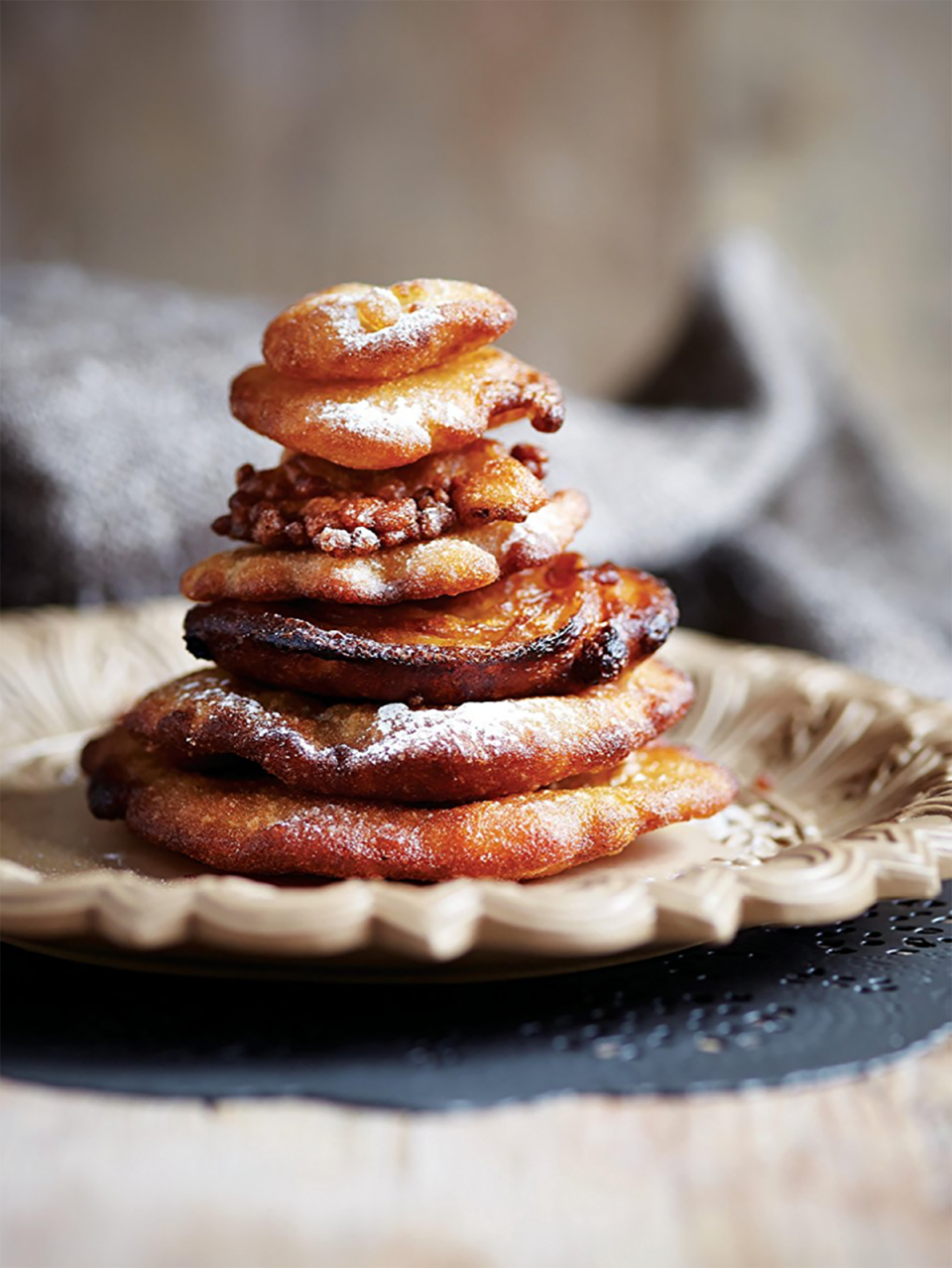
This recipe is courtesy of my mother!
This is a very simple dessert but a firm family favourite in the Singh household when we were growing up. It is a classic north Indian home recipe that has a million variations and each family believes theirs is the best. These are especially popular and often served as snacks during the festival of Holi. Even though we are rarely home with my mother for Holi, to her it doesn’t feel like Holi if she hasn’t made a few malpuas. She will make five at least, eat one herself and feed the remaining four (one of each of us) to the cows, the birds and the bees, to symbolise that we have eaten and celebrated Holi as it was meant to be.
Serves: 4-6
Ingredients:
200g plain flour
160g sugar
Enough milk to make a smooth pouring batter (about 400ml)
½ tsp green cardamom powder
1 tbsp golden raisins
½ banana, mashed (optional)
Vegetable oil for deep frying
Method:
Mix together all the ingredients to make a smooth batter, and then set aside in the fridge for 2-3 hours to allow the flavours to develop.
Pour the oil in a wok to the depth of around 5cm, then heat to medium-hot.
Mix the batter using a spoon, then pour the batter into medium-hot oil to fry for 3-4 minutes until the edges are crisp and the middle of the pancakes are still soft. Turn over halfway during the cooking process when the underside is golden and crisp.
Drain using a slotted spoon, let cool for a minute or so, and then serve with ice cream of your choice or on its own.
This mixture will make approximately 16-20 pancakes.

